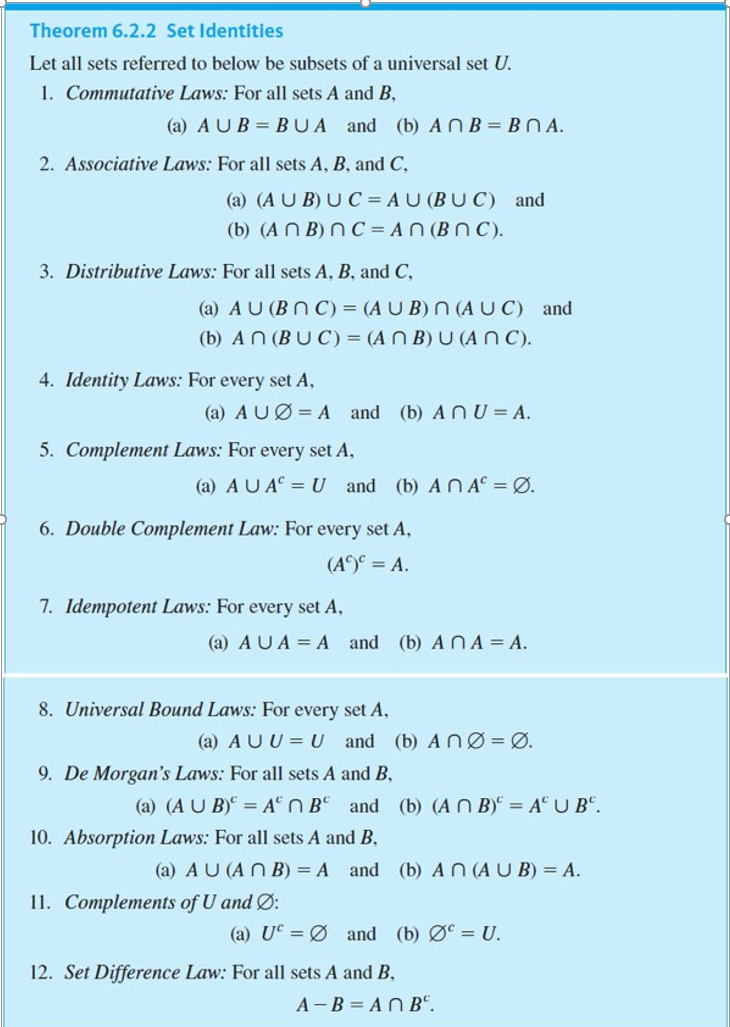(a) Prove the following statement using the element method for proving that a set equals the empty set: For all sets A and B, AN(B – A) = (). (b) Use the properties in Theorem 6.2.2 shown below to prove the statement in part (a), Be sure to give a reason for every step.
(a) Prove the following statement using the element method for proving that a set equals the empty set: For all sets A and B, AN(B – A) = (). (b) Use the properties in Theorem 6.2.2 shown below to prove the statement in part (a), Be sure to give a reason for every step.
Elements Of Modern Algebra
8th Edition
ISBN:9781285463230
Author:Gilbert, Linda, Jimmie
Publisher:Gilbert, Linda, Jimmie
Chapter7: Real And Complex Numbers
Section7.1: The Field Of Real Numbers
Problem 5TFE: Label each of the following statements as either true or false.
If a nonempty set contains an upper...
Related questions
Question

Transcribed Image Text:(a) Prove the following statement using the element method for proving that a
set equals the empty set: For all sets A and B, AN(B – A) = ().
(b) Use the properties in Theorem 6.2.2 shown below to prove the statement in
part (a). Be sure to give a reason for every step.

Transcribed Image Text:Theorem 6.2.2 Set Identities
Let all sets referred to below be subsets of a universal set U.
1. Commutative Laws: For all sets A and B,
(a) AUB = BUA and (b) ANB = BNA.
2. Associative Laws: For all sets A, B, and C,
(a) (A U B) U C = AU (BUC) and
(b) (A N B) NC = AN (BN C).
3. Distributive Laws: For all sets A, B, and C,
(a) AU (BN C) = (A U B) N (A UC) and
(b) AN (BUC) = (A N B) U (AN C).
4. Identity Laws: For every set A,
(a) AUØ = A and (b) A N U = A.
5. Complement Laws: For every set A,
(a) AUA° = U and (b) A NA° = Ø.
6. Double Complement Law: For every set A,
(A) = A.
7. Idempotent Laws: For every set A,
(a) AUA = A and (b) A NA = A.
8. Universal Bound Laws: For every set A,
(a) AUU= U and (b) A nØ=Ø.
9. De Morgan's Laws: For all sets A and B,
(a) (AU B) = A“N B° and (b) (AN B)° = A° UB".
10. Absorption Laws: For all sets A and B,
(a) AU (A N B) = A and (b) AN (AU B) = A.
11. Complements of U and Ø:
(a) UC = Ø and (b) Ø = U.
12. Set Difference Law: For all sets A and B,
A -B = ANBº.
Expert Solution
This question has been solved!
Explore an expertly crafted, step-by-step solution for a thorough understanding of key concepts.
This is a popular solution!
Trending now
This is a popular solution!
Step by step
Solved in 3 steps

Knowledge Booster
Learn more about
Need a deep-dive on the concept behind this application? Look no further. Learn more about this topic, algebra and related others by exploring similar questions and additional content below.Recommended textbooks for you

Elements Of Modern Algebra
Algebra
ISBN:
9781285463230
Author:
Gilbert, Linda, Jimmie
Publisher:
Cengage Learning,

Elements Of Modern Algebra
Algebra
ISBN:
9781285463230
Author:
Gilbert, Linda, Jimmie
Publisher:
Cengage Learning,